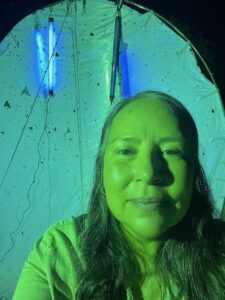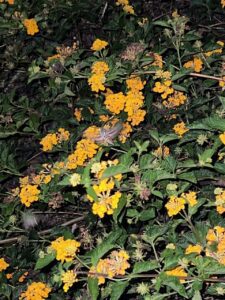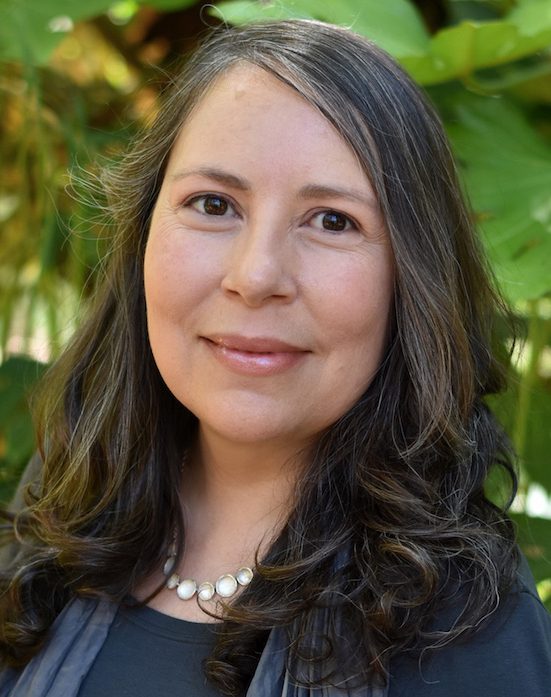Adriana Darielle Mejía Briscoe, a 2021 Guggenheim Fellow in Biology, is a professor of ecology and evolutionary biology at the University of California, Irvine. There, she leads a lab that studies the evolution of butterfly vision and coloration, and how those characteristics link to behavioral traits. She has researched how butterflies use color to identify their own species, find mates, and ward off predators. Recently, her lab’s work on male and female longwing butterflies’ difference in color perception was featured in the New York Times, which has opened other new lines of inquiry into what we can learn from butterflies’ sex chromosomes.
During her Fellowship year, Adriana began working on a book about butterflies’ response to climate change—a project which has continued to evolve. Read on to learn more.
Guggenheim Foundation: Thanks for speaking with us, Adriana. What are you working on right now?
Adriana Briscoe: I am working on so many different things! Some of the things I’m working on are spinoffs of the book project and some of the things are long term projects like the one that was just published in the Proceedings of the National Academy of Sciences, where we discovered that there are some butterflies where the females have ultraviolet color vision but the males are colorblind. …We found this particular vision gene jumped from an autosomal chromosome to a sex chromosome, which makes this trait obligately female-specific. This gene jumping directly onto the sex chromosome is potentially a new mechanism for how sex differences originate genetically. We weren’t entirely able to resolve when this event occurred within evolutionary time, so what we’re trying to do is obtain funding to continue the work to study other butterflies, which would help us pinpoint when this event occurred and shed light on this novel way of creating differences between the sexes.
GF: That’s fascinating.
AB: Yes! So the group of butterflies that has this interesting sexual dimorphism, they’re called Heliconius or longwings or Passion vine butterflies. They have been studied since the 19th century, certainly by western naturalists like Bates and Darwin and Fritz Müller. And they’ve been studied because they have these beautiful wing colors that also have evolved to resemble the wing colors of other distantly related butterflies. They’re bright, bright, bright colors. And those bright colors signal that they’re also unpalatable to predators like birds and lizards. And so their wing colors signal “don’t eat me.” They’ve been studied for a long time because of the fascinating way in which these color patterns evolve between different geographical locations and between species. I started working on their visual system when I was a graduate student. I wrote a research grant to the National Science Foundation… and got funding to…start the work on their visual system. And so, you could say that I’ve been working on this group of butterflies since 1995, and the work that we published this past week is the direct result of novel discoveries of the visual system that have been sustained the entire time by students in my biology laboratory.

GF: It’s so interesting to think about that kind of legacy, and the years and years of scientific discovery that keep being built on and subverted by having surprises—like your lab’s discovery—appear. I wonder if we could go back to the very beginning: pre-grad school, did you have an interest in insects or biology at all? Were you a kid who loved bugs?
AB: I had a formative experience with bugs when I was in middle school. … I lived in a suburb of what we call the Inland Empire of Southern California. You know, Southern California’s the land of freeways. And so the opportunity to be out in nature really only happened for me in the summer when my parents would take my brother and I camping on long car trips. I’d get to explore around the campsite and see things that way. But generally, during the rest of the year, I didn’t really see much of nature. But when I was in middle school, my mother sent me to summer camp at the local county museum, the San Bernadino County Museum. Unbeknownst to me—and actually a wonder to me—is that in the Mojave Desert there are insect microfossils that can be found. They’re in these little tiny accretions that kind of look like macarons, the little cookies. If you drop them in a dilute solution of acid, the fossils pop out. And so when I was in this summer camp, it was being led by this pair of geologists, and they gave each kid one. We got to look for microfossils under a dissecting scope. And what’s amazing is that some of these microfossils contain insects that still have their compound eyes. So under the dissecting scope, you can actually see little faceted eyes. It was a completely memorable, incredible experience at that age. I wanted more fossils… I just didn’t know how to get my hands on them.
GF: It sounds like that kind of wonder has guided a lot of your studies and experiments in your academic life.
I’d love to hear a little bit about what your Guggenheim project was. How did you first envision it? And how has it changed and led you in any other directions?
AB: I first proposed to write a popular science book very much focused around the scientists and the butterflies that they’re studying in relationship to the problem of climate change and global warming. How they deal with extreme temperatures, how do they heat up, how do they cool off? And looking at everything from the level of an electron microscope—that level of detail—up to even potentially a migration of butterflies. The themes that I wanted to cover are the same still, but what I’ve discovered is that I’ve become incredibly interested in the human dimension of the relationship between humans and butterflies. And so my project has shifted somewhat because I’ve become interested in telling place-based stories about butterflies and their relationship to the people that live there, including indigenous people, because we have some kinds of butterflies that are endangered that are only found in the traditional lands of specific indigenous people who have been colonized. And so you can’t really talk about global warming and climate change without also talking about why it happened and why there is a need for conservation. The reason why there’s a need for conservation is because of processes like colonization, industrialization, and loss, the rise of the use of chemicals and pesticides, which can exacerbate stresses on animal populations and the loss of lands by indigenous people. When I really started working on this project, I realized that the New World—in particular Mesoamerica—has a very ancient relationship with butterflies, and there is a very, very deep relationship throughout Mesoamerican and different indigenous populations in the U.S. to butterflies. And so I’ve become very interest in learning these stories and talking to folks and just taking a deep dive into this other aspect of it. Like: why butterflies have turned out to be so important for the ancient people of the new world? How is this connected to ideas of emergence or transformation or notions of a paradise? So I’ve started to weave into my science storytelling some of these other stories. I’ve been interviewing folks.
What I’ve discovered is that I’ve become incredibly interested in the human dimension of the relationship between humans and butterflies.
GF: It sounds like it’s evolved to include history and storytelling and even myths and the way we all try to make sense of the world.
In those interviews and conversations, do you feel like there are any larger human themes about what people learn about themselves from insects?
AB: That’s a great question. There are different ways of answering that question—and I know there is an answer to that question that has to do with this ancient deep culture—but what came to mind was that I just drove to Arizona from California to spend several days with some scientists who are studying hawk moths. They’re very interested in how hawk moths are dealing with the problem of little to no water in the desert. How do they live in these extreme environments where it’s really hot and there’s hardly any water? And I wanted to go with them to their field sites because I wanted to see in nature how the hawk moths behave. And in particular, I was interested in observing their feeding behavior because they’re known to collect nectar from particular kinds of flowers, and also lay eggs on particular kinds of plants. And some of these plants are sacred to the native people of the Southwest, and they have been represented in pre-Columbian art for more than a thousand years. There are ceramics with hawk moth flowers on them, and occasionally something that looks like the hawk moth itself. So I was very interested in going out there and seeing these hawk moths. So, at dusk, I sat in the field for an hour with some eminent entomologists and no hawk moths appeared. We were sitting there in front of these datura flowers. The flowers opened up. They emit this wonderful odor. Tons of beetles show up, but no hawk moths. So, you know, I had driven all this way to go see these hawk moths and I wasn’t able to see them sipping nectar from these flowers.
But then I come home to suburban Orange County, California, and I go for a walk around my neighborhood, and I see a hawk moth. And it’s very interested in a flower that I would never think of as a hawk moth flower called bougainvillea. It’s visiting every single tiny white flower on the bougainvillea. And then right next to bougainvillea is this plant—I think it’s called society garlic—but it’s a cultivar that is planted everywhere. It started foraging on that. And then I saw it foraging on something called Agapanthus. These are all things that are used in, like, suburban plantings. They’re not native plants that the hawk moth would have evolved with. And so then I walk around the corner and see…a large number of yellow Lantana flowers spread out all over an embankment, and there were dozens of hawk moths foraging on these Lantana. I was astonished. I had never seen so many adult hawk moths in my entire life. Like usually, when I’ve seen them, I’ve seen one at a time.

This all goes back to your question about the relationship between us and insects. I had this idea that I needed to go on a long journey. I needed to get in my car are drive 600 miles, or, you know, get on a plane and fly to South America to have this experience of this wondrous behavior—and it turned out all I had to do was walk around my neighborhood. And I think this is true for just about everybody. You know, if your mind is open and your eyes are open, it’s out there. Even in suburbia.
GF: I love that story. I imagine that with climate change, hawk months are being forced to adapt to less water; they’re being forced to adapt to new plants, to choosing bougainvillea over the flowers that they would more naturally gravitate towards. I know it’s never this simple, but does seeing insects adapt like this make you more or less hopeful about the world as we know it, and the survival of these species?
AB: I would say that from interviewing ecologists who have been surveying butterflies and moths for decades and are continuing to survey and have been involved in these studies of abundances that I’ve become more hopeful about the role of urban gardens—that all of our cultivated spaces can play a role in the way the population’s going. If they can’t find those flowers in the nature preserve, but if we have some flowers in our backyard the adults can get some nectar and they can get enough energy to mate and reproduce. I think a big part of that, though, depends on our choices. If we’re gardening and we decide that we don’t like a little bit of messiness, and therefore we’re going to go buy a bunch of chemicals to either get rid of the messy plants by spraying herbicide or a lot of pesticides, well, then, of course we’re not going to help. But if people are willing to step back from that, I do feel hopeful. I do feel like there’s a possibility for saving and maintaining and renewing some of our species declines that we’ve observed. I mean, there’s no way we’re going to go back to the way it was. But yeah, I feel a lot more hopeful.
GF: Can I ask what you’re working on now?
AB: I have a fun project that I’m working on that has nothing to do with my academic subject which is evolutionary biology. But working on this Guggenheim project has really opened my eyes to interdisciplinary projects. So, I have a mapping project right now: I’m trying to map all of the places in North America that are named for butterflies or caterpillars. This may sound really odd. But we are focusing on indigenous languages and we’re starting in Mexico. We started with one language, which is the language of the Aztecs, and there are dozens of places in Mexico named for either butterfly or caterpillar. And so we’re trying to map this by creating a catalogue of those words in different indigenous languages and then doing map searches for places names that are derived from those words. There are a lot, including in the U.S., with indigenous names that mean butterfly.
GF: How interesting. You’re actually the second Fellow I’ve spoken to recently that has talked about the Guggenheim Fellowship really opening up ideas about interdisciplinary projects.
AB: Yeah, it makes me really happy. I think being awarded a Fellowship kind of gave me permission to pursue other lines of inquiry. You know, stuff that I’ve been curious about but had no official reason to look into. It’s given me permission to do that. And it has been marvelous.
This interview has been edited and condensed for clarity.
